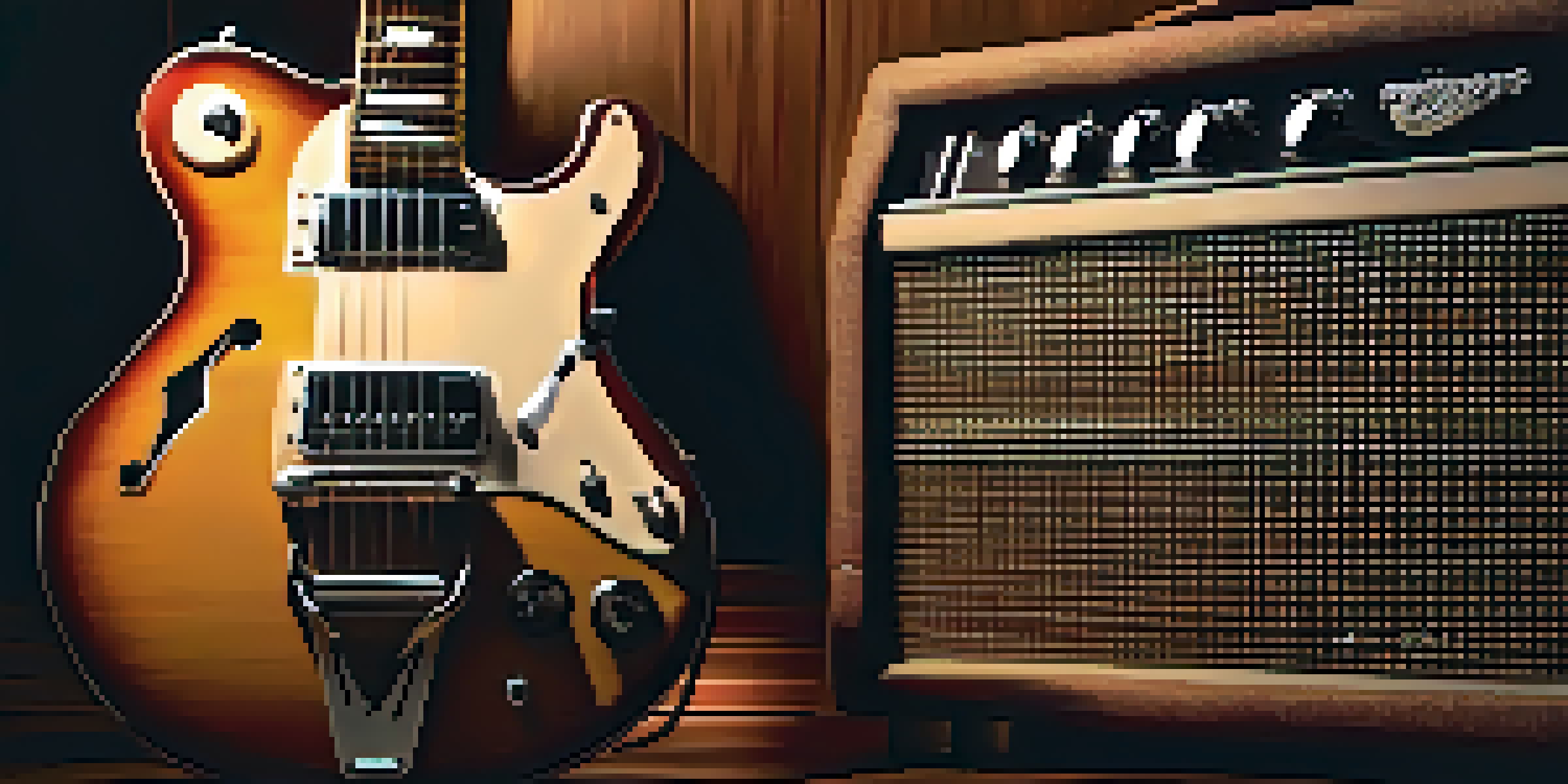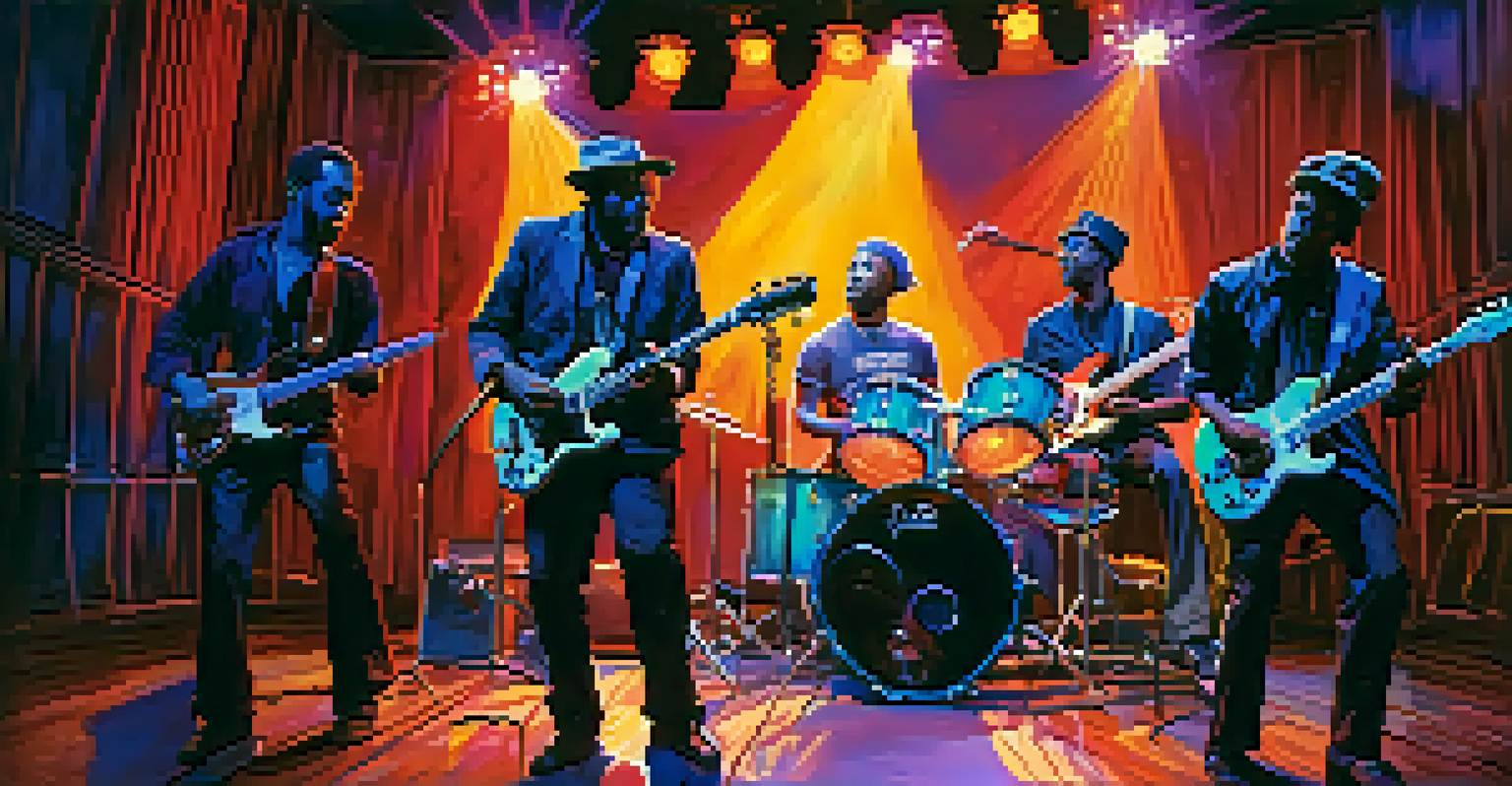Exploring the Richness of Blues Guitar Techniques and Styles

The Roots of Blues Guitar: A Brief Overview
Blues guitar has deep roots in African American history, emerging from the rich traditions of spirituals and work songs. It evolved in the Mississippi Delta during the late 19th and early 20th centuries, influenced by various musical styles. This unique blend of cultural influences laid the groundwork for the blues genre, which would go on to shape countless music styles, including jazz and rock.
The blues is a lowdown shakin' chillin' thrillin' sound.
The heart of blues music lies in its emotional expression and storytelling. Musicians often convey personal struggles, joys, and life experiences through their songs, making it a powerful medium of communication. The guitar serves as a vital tool in this storytelling, allowing artists to articulate their emotions through melody and rhythm.
Understanding the origins of blues guitar can enhance our appreciation for the techniques and styles that have developed over time. Each guitarist brings their own background and experiences to the table, contributing to this ever-evolving genre. By exploring these roots, we can better grasp the richness of blues guitar and its significant cultural impact.
Essential Blues Guitar Techniques to Master
To truly capture the essence of blues guitar, certain techniques are essential for any aspiring guitarist. Techniques like bending, sliding, and hammer-ons create expressive sounds that resonate with the emotional core of the music. Bending a note, for example, allows musicians to add a soulful quality that can mimic the human voice.

Another crucial technique is the use of vibrato, which adds depth and intensity to notes. By subtly oscillating the pitch of a note, guitarists can infuse their playing with a sense of urgency or longing. Mastering these techniques can significantly enhance your ability to convey the emotional weight of blues music.
Blues Guitar's Rich Cultural Roots
Blues guitar emerged from African American traditions, deeply intertwined with spirituals and work songs, shaping its emotional expression.
Furthermore, incorporating fingerpicking and alternate picking can diversify your playing style. Each technique brings its own flavor, allowing you to explore the various facets of blues music. As you experiment with these techniques, you'll find your unique sound and style within the rich world of blues.
Exploring Different Blues Guitar Styles
Blues music is not a monolith; it encompasses a variety of styles that reflect different regional influences and personal interpretations. From Delta blues, characterized by its raw acoustic sound, to Chicago blues, which embraces electric guitars and a more polished production, each style offers a unique listening experience. Understanding these distinctions can deepen your appreciation for the genre.
Blues is the root, and all the other music is the fruit.
Texas blues, for instance, incorporates elements of jazz and swing, adding a lively flair to the traditional blues sound. Artists like Stevie Ray Vaughan exemplify this style, showcasing impressive guitar work that blends blues with rock influences. Each regional style not only showcases different techniques but also tells a story of its cultural background.
By exploring these diverse styles, you can discover which resonates most with your musical preferences. You may even find inspiration to blend elements from various styles into your own playing. This fusion of influences is what keeps blues music vibrant and continually evolving.
Famous Blues Guitarists and Their Signature Styles
Throughout the history of blues, several guitarists have left indelible marks on the genre with their unique styles. B.B. King, often referred to as the 'King of Blues,' is celebrated for his expressive string bending and soulful vibrato. His ability to convey emotion through his guitar has inspired countless musicians across genres.
Another iconic figure, Muddy Waters, is known for pioneering the Chicago blues sound. His electrifying performances and innovative use of amplification transformed blues music, making it more accessible to larger audiences. Waters’ style blended traditional elements with modern techniques, showcasing the genre's adaptability.
Blues Guitar's Rich Cultural Roots
Blues guitar emerged from African American history, reflecting deep emotional expression and storytelling through varied musical influences.
These legends not only shaped blues guitar but also influenced generations of musicians. By studying their techniques and signature styles, aspiring guitarists can glean valuable insights that can be applied to their own playing. Their legacies remind us of the power and creativity that blues guitar embodies.
The Role of Improvisation in Blues Guitar
Improvisation is a cornerstone of blues music, allowing guitarists to express their individuality and creativity. Unlike many genres that rely on strict compositions, blues often provides a framework for musicians to explore their emotions in real-time. This spontaneity is what makes live blues performances so captivating and unique.
When improvising, guitarists draw from their knowledge of scales, chords, and techniques, weaving them together to create something fresh. The blues scale, with its distinctive notes, serves as a popular foundation for improvisation, enabling musicians to craft solos that resonate with the audience. This interplay of structure and freedom is a hallmark of blues music.
Moreover, improvisation encourages collaboration among musicians, fostering a dynamic exchange of ideas during performances. This communal aspect not only enriches the music but also creates an engaging experience for both performers and listeners. Embracing improvisation can unlock new dimensions in your blues guitar playing.
The Influence of Blues on Modern Music Genres
The influence of blues guitar extends far beyond its own genre, permeating various modern music styles. Rock, jazz, and even hip-hop have drawn inspiration from the emotional depth and improvisational spirit of blues music. This cross-pollination has led to the creation of innovative sounds that resonate with diverse audiences.
For instance, rock legends like Eric Clapton and Led Zeppelin have incorporated blues elements into their music, paying homage to the genre's roots. Their guitar work often showcases techniques like bending and slide guitar, which are hallmarks of blues. This melding of styles has not only popularized blues but has also kept it alive in contemporary music.
Essential Techniques for Blues Playing
Mastering techniques like bending, vibrato, and improvisation is crucial for capturing the soulful essence of blues guitar.
Furthermore, the ongoing dialogue between blues and modern genres continues to evolve, with new artists blending these influences in exciting ways. Genres like blues-rock and soul-blues are testaments to this dynamic relationship. As music continues to grow and change, the impact of blues guitar remains a vital part of its narrative.
Tips for Developing Your Blues Guitar Skills
Developing your blues guitar skills requires practice, patience, and a willingness to explore. Start by learning fundamental techniques such as bending and vibrato, as these will form the backbone of your playing. Consistent practice with these techniques will help you develop muscle memory and confidence in your abilities.
Listening to a wide range of blues artists is also crucial for growth. By immersing yourself in different styles and techniques, you can gain inspiration and insight into what makes each artist unique. Try to play along with recordings to improve your timing and adaptability, as this can enhance your overall musicianship.

Lastly, don’t shy away from improvisation. Set aside time during your practice sessions to experiment with creating your own solos and melodies. This not only builds your creativity but also helps you find your voice as a guitarist, making the learning process both enjoyable and rewarding.